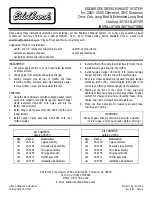
PRE-SAFE
®
intervenes:
R
in emergency braking situations, e.g. if BAS
is activated or for vehicles with DISTRONIC
PLUS, BAS PLUS intervenes powerfully
R
if the radar sensor system detects an immi-
nent danger of collision in certain situa-
tions (on vehicles with DISTRONIC PLUS)
R
in critical driving situations, e.g. when phys-
ical limits are exceed and the vehicle under-
steers or oversteers severely
PRE-SAFE
®
takes the following measures
depending on the hazardous situation detec-
ted:
R
the front seat belts are pre-tensioned.
R
vehicles with the memory function: it
adjusts the front-passenger seat if it is in
an unfavourable position.
R
if the vehicle skids, the sliding sunroof/
panorama sliding sunroof and the side win-
dows are closed so that only a small gap
remains.
If the hazardous situation passes without
resulting in an accident, PRE-SAFE
®
slackens
the belt pretensioning. All settings made by
PRE-SAFE
®
can then be reversed.
If the seat belts are not released:
X
Move the backrest or seat back slightly, but
only when the vehicle is stationary.
The belt pretensioning is reduced and the
locking mechanism is released.
G
WARNING
When adjusting the seat, make sure that
nobody can become trapped.
!
Make sure that there are no objects in the
footwell or behind the seats when moving
the seat back. There is a risk that the seats
and/or the objects could be damaged.
More information about seat-belt adjust-
ment, a convenience function integrated into
PRE-SAFE
®
, can be found in the "Seat-belt
adjustment" section (
Y
page 48).
Seat belts
Important safety notes
Seat belts are the most effective means of
restraining the movement of vehicle occu-
pants in the event of an accident. This
reduces the risk of vehicle occupants coming
into contact with parts of the vehicle interior.
G
WARNING
A seat belt which is not worn correctly, or
which has not been engaged in the seat belt
buckle correctly, cannot perform its intended
protective function. Under certain circum-
stances, this could cause severe or even fatal
injuries in the event of an accident.
Make sure that all occupants – in particular,
pregnant women – wear their seat belt cor-
rectly at all times.
R
The seat belt must fit snugly on your body
and must not be twisted. Therefore, avoid
wearing bulky clothing, e.g. a winter coat.
The shoulder belt section must be routed
across the centre of your shoulder – on no
account across your neck or under your
arm – and pulled tight against your upper
body. The lap belt must always pass across
your lap as low down as possible, i.e. over
your hip joints – not across your abdomen.
If necessary, push down the belt strap
slightly and then retighten it in the roll-up
direction.
R
Do not route the belt strap across sharp
edges or fragile objects, especially if these
are located on or in your clothing, e.g. spec-
tacles, pens, keys, etc. The seat belt strap
could be damaged and tear in an accident,
and you or other vehicle occupants could
be injured.
R
Only one person should use each seat belt
at any one time. Children must never travel
sitting on the lap of other occupants. It
would not be possible to restrain the child
in the event of a sudden change in direc-
tion, braking or an accident. This could
46
Occupant safety
Safet
y
Содержание CLS 2011
Страница 2: ......
Страница 3: ......
Страница 5: ......
Страница 29: ...26...
Страница 41: ...38...
Страница 93: ...90...
Страница 107: ...104...
Страница 297: ...294...
Страница 298: ...Useful information 296 Loading guidelines 296 Stowage areas 296 Features 306 295 Stowing and features...
Страница 320: ...Useful information 318 Engine compartment 318 Maintenance 322 Care 324 317 Maintenance and care...
Страница 371: ...368...
Страница 387: ...384...
Страница 388: ......
Страница 389: ......
















































